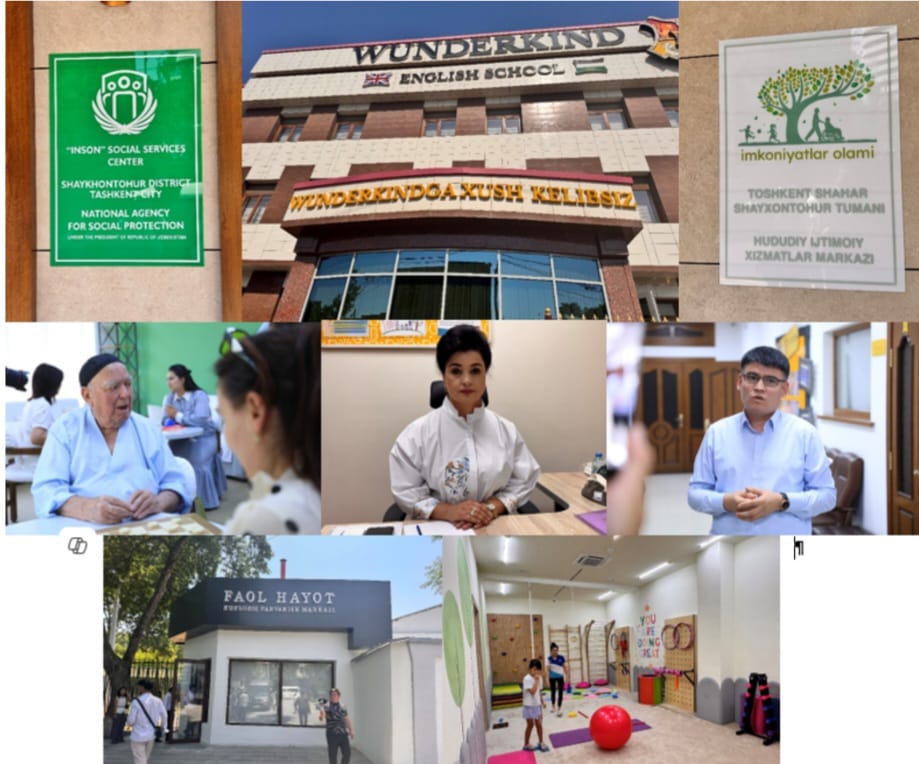Since 2017, President Shavkat Mirziyoyev’s administration has pursued a sweeping reform agenda, liberalizing the economy while strengthening social welfare. These reforms are enshrined in new policies and the 2023 Constitution, which explicitly defines Uzbekistan as a “social state” responsible for ensuring employment and reducing poverty.
The government’s national strategy (“Uzbekistan–2030”) even set a target of halving poverty by 2026. In short, Uzbekistan’s policy framework has shifted toward the combined goals of economic growth and inclusive social protection.
By 2023 the new National Agency for Social Protection (NASP) and community “Inson” service centres were delivering aid to roughly 2.3 million needy families – about a four-fold increase from 2017. Pensions and basic benefits were also raised: for instance, pension and disability payments in real terms are now about 1.5 times higher than before the reforms.
Community service is delivered through Inson centers, one-stop offices in each locality that help citizens apply for benefits and services. These “Inson” centres provide personal assistance with applications and information, reflecting a shift to integrated, client-oriented support. Relatedly, a new registry of persons requiring care has been established (by 2023 it contained ~17,800 profiles) to manage support for the disabled and elderly; each case is reviewed quarterly so that aid can be adjusted as needed. Together, these digital tools and organizational changes – one-stop “Inson” centers, a unified registry, targeted lists and case management – represent a modern social protection architecture far beyond Uzbekistan’s previous fragmented system.
International partners have closely supported and evaluated these reforms. The World Bank has played a leading role: it delivered roughly $2.1 billion through policy-based loans (2018–2021) to finance structural reforms in jobs, governance and social policy. In mid-2024 the Bank approved an additional $100 million “INSON” project to improve social care for vulnerable groups. This project will establish more than 50 community-based social service centres and expand services to some 50,000 people (including older persons, disabled, and children).
Within the framework of the “From Poverty to Prosperity” program, launched on 1 November 2024, families receive support across seven key dimensions:
– Ensuring stable employment and achieving higher income levels;
– Access to education and vocational training;
– Access to guaranteed state healthcare services;
– Access to social services;
– Improvement of housing conditions;
– Development of mahalla (community) infrastructure by the state;
– Direct engagement and dialogue with public sector representatives.
More than 600,000 families have gained access to 1.3 million social services aimed at employment and income growth. Members of these families have also benefited from over 2.2 million guaranteed healthcare services, directly contributing to their sustainable participation in the labor market.
Expanding Social Care Provision
For individuals requiring continuous care, a new model of service provision through private providers has been introduced. These services include household assistance, home- and field-based care, medical and social rehabilitation, and personal assistant support. Currently, 13,800 individuals, representing 76% of all those in need of care, receive such services from the private sector.
According to the Presidential Decree of the Republic of Uzbekistan, by 2030 the number of recipients of social services is expected to reach at least 3 million citizens annually, while the share of services provided by the non-state sector will rise to 30%. This approach fully aligns with the principles of the social and solidarity economy.
The programs implemented by the National Agency for Social Protection are characterized as accessible, effective, and oriented toward sustainable economic development.
- Accessibility
As part of the “From Poverty to Prosperity” program, a National Registry of Poor Families has been established. The identification of households and decisions regarding their inclusion are made directly at the community (mahalla) level. As of today, 667,000 families, comprising approximately 2.8 million individuals, have been registered. This provides a comprehensive understanding of their living conditions and the opportunities for poverty reduction.
- Effectiveness
In the first nine months of the current year, the average per capita income among registered families has nearly doubled, rising from 174,000 soums (~USD 14) to 338,000 soums (~USD 27) per month. Furthermore, 73,000 families that previously had no income now earn official wages. During the same period, 150,000 families have successfully escaped poverty, with 105,000 (70%) doing so primarily due to increased formal employment income.
- Sustainability
To ensure targeted support, families are categorized into three groups:
– Red – households with persons with disabilities requiring care, as well as families without a breadwinner or headed by a single parent;
– Yellow – families with employable members but lacking stable income and professional skills;
– Green – families that have exited poverty but remain at risk of falling back.
This classification enables the application of differentiated measures: “red” families receive priority care and social support; “yellow” families are targeted with employment and training programs; and “green” families benefit from measures aimed at preventing a return to poverty.
Within this framework, the development of a “care economy” has emerged as a key priority. The Agency has introduced daycare services for children with disabilities and the “Step into an Active Life” program for older persons. These initiatives enable family members to participate in the labor market, thereby activating previously unpaid caregivers.
Investing in Human Capital
Particular attention is given to children from low-income families. The state subsidizes up to 90% of the costs associated with their education and development. In 2025, 125,000 children from poor households gained preferential access to preschools, demonstrating how social protection systems can make an indirect yet significant contribution to poverty reduction.
In conclusion, the programs implemented by the National Agency for Social Protection go far beyond material support. They create enabling conditions for income generation, employment, and human capital development, thereby contributing directly to the sustainable economic growth of the country.
Olima Almatova Qorabekovna, a resident of “Ezgulik” makhalla, Buka district, Tashkent region, who received support from the Agency, said:
“My spouse worked at the mining combine for forty years, but after he became ill, he could no longer continue. For his sake, I took on whatever jobs people offered me. When the doctors suggested placing stents in his heart arteries, I refused, saying: ‘Whatever help you can give, give it to my family. I’ve lived my life, I am already sixty-seven. I’ve seen so much, whatever comes, I will accept it. I don’t need stents. I only ask that you give a little help to my family.’
When support arrived under the President’s decision, I cannot express how happy I was. I said: ‘Oh God, there really is someone who came to open my door.’ They came and extended a helping hand. We planted cucumbers and tomatoes, and soon money began to come in. We have already earned income three times. So much support has reached us, and we are deeply grateful to our President. Feeding even one family is difficult, yet he is taking care of millions. For those who are struggling and in need, such help gives strength, brings joy, and inspires them to move forward. One can hardly imagine just how powerful that is.”
In conclusion, the programs implemented by the National Agency for Social Protection go far beyond material support. They create enabling conditions for income generation, employment, and human capital development, thereby contributing directly to the sustainable economic growth of the country.


